by Winding Pathways | Jun 13, 2019 | Foraging, Weeds
Every summer we enjoy dining on Swiss chard and spinach, but one of our favorite greens to come from the garden is lamb’s quarters. It’s a plant with many common names that is ready to pick and eat before chard or spinach mature. Some call the plant pigweed but that name is also used for other species. Lamb’s quarters remain edible through the summer as long as only tender young leaves are plucked.
Lamb’s quarters is a “no work” green. We never plant, cultivate, or water it. It’s not necessary. It’s a weed that plants itself and pops up in the garden and on the edge of the lawn. We only have to pick, wash, cook, and eat it.
What IS Lamb’s Quarters?
This amazing garden and yard weed grows almost everywhere in the United States and probably lives near just about every person. A usually disliked garden chore is pulling or hoeing weeds. Often those weeds are just discarded or composted. It’s ironic that often those weeds are tastier and more nutritious than the crop being weeded. Lamb’s quarters is one of the best and easiest of the edible weeds.
Lamb’s quarters is an erect branched plant with leaves that shed water. Sprinkle a few drops on the plant and they’ll either bead up or run off, leaving the leaf dry. Try it!
How Do You Process Lamb’s Quarters?
We pick a small pot full of young lamb’s quarter leaves and stems, rinse them well, and steam or boil them for about ten minutes. They are delicious when topped with a dab of butter or a bit of oil and vinegar. Lamb’s quarters cook down significantly, so a pot full of raw leaves will yield only a small amount of cooked vegetables. Pick plenty. If the plant is allowed to mature the tiny seeds are also edible and nutritious but processing them is beyond tedious. Lamb’s quarter leaves can also sparingly be used raw in salads.
-
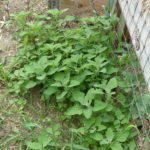
-
Lamb’s Quarters readily grow in disturbed soil.
-
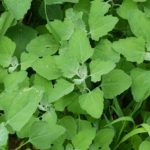
-
The silvery leaf sheds water.
-
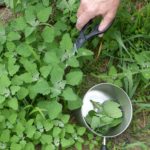
-
A full pot of raw Lamb’s Quarters cooks down to a few fork fulls of this nutritious potherb.
Caveat!
Before eating a new wild plant make sure you have correctly identified it from at least two reputable sources, such as wild edible books, the Internet, or a skilled foraging mentor. Then only eat a small amount the first time. Occasionally a plant may be delicious and harmless to most people but allergic to a few.
Use Identification Sources
Our favorite sources for wild edible information are the classic Stalking the Wild Asparagus book by Euell Gibbons and A Field Guide to Edible Wild Plants by Lee Peterson. Many websites also feature this plant. A helpful website is Edible Wild Food.
by Winding Pathways | May 24, 2018 | (Sub)Urban Homesteading, Flowers/Grasses, Foraging, Garden/Yard, Garden/Yard, Weeds
Years ago, a homeowner visited a garden store and bought plugs of a plant commercially called ground ivy, but most folks today call it Creeping Charlie.
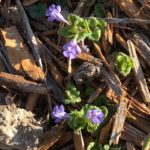
A great ground cover that can get away from you.
In many ways this exotic plant was an ideal ground cover. It’s tough, easy to transport and plant, adaptable to a wide range of conditions, needs no special care, and it spreads like crazy. It only grows a few inches tall so was touted as a plant that, once established, needs no maintenance. And, it attracts valuable pollinators early in the season before other flowering blooms appear.
Benefits
Creeping Charlie’s benefits are also its curse. It does everything too well. Creeping Charlie doesn’t creep. Rather, it races to cover a yard with astonishing speed, often crowding out more desirable plants.
There are two ways to view Creeping Charlie.
It’s either a pernicious pest or a friend that needs little care. At Winding Pathways, we look at it both ways depending on where it’s growing. When it’s crowding wildflowers or our garden vegetables we rip it out of the ground. In places where it can’t infect a garden or native wildflowers we leave it be and know we won’t need to mow that area often.
Controlling Creeping Charlie
There are lots of ways to control Creeping Charlie. We pull it out of the ground. Roundup and other herbicides kill it, and it’s possible to smother it under black plastic sheeting. Mulch works for a while but soon the plant will thrive on even a thick layer of shredded wood mulch.
A member of the mint family and also known more romantically by an elderly Irish friend as “Gill-Over-the-Ground”, Creeping Charlie is also edible steamed, added to omelets or brewed as a tea.
Other Ground Covers
We prefer ground covers that are less aggressive than Creeping Charlie. One of our favorites is the native Pussy Toes, which grows in patches in our lawn. We planted some when we moved in eight years ago and because we don’t put herbicides on our lawn it is spreading nicely. It is hardy and thrives in dry, sandy soil in baking sun. The hairy, silvery leaves lie close the ground and in spring send up enchanting stems with little “pussy toe” flowers. The Lady Bird Wildflower Center confirms this native plant is widely spread and thrives in open meadows and woodlands and rocky areas. We’ve seen it all over the eastern half of the country and Canada. We love it! Again, it saves mowing, adds color and texture to the landscape and attracts early season pollinators.
We also use Vinca, with its periwinkle flowers, on some parts of our lawn especially areas we do not want to mow. It spreads easily, adds color and texture to the landscape and reduces maintenance.
-
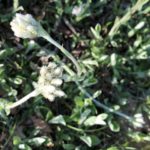
-
Pollinators like ants flock to pussytoes.
-
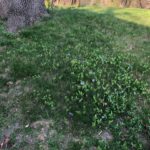
-
An excellent ground cover.
-
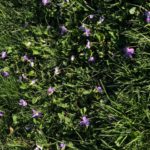
-
Pretty purple violets.
Our lawn actually is a mosaic of many plants. Since we shun herbicides we have a lawn blend of grasses, violets, dandelions, pussytoes, and many other plants. They are all fascinating and help pollinators through the seasons.
by Winding Pathways | Mar 7, 2017 | (Sub)Urban Homesteading, Flowers/Grasses, Foraging, Nature, Weeds
As soon as a few warm days arrive early each spring we search our yard at Winding Pathways for two of our favorite plants – Stinging Nettles and Dandelions.
To most people they’re weeds. To us they’re delicious yard gifts.
STINGING NETTLES
Stinging nettles are one of the tastiest of all wild greens. They begin growing very early each spring and are usually ready to pick about the time when gardeners plant spinach and lettuce. In Iowa that’s sometime in April. Nettles love moist soil at the edge of woods where they receive partial shade. Often they’re common on yard edges. Nettles are well named, because they can sting! Another name for the plant is “three minute itch”, because the slight stinging sensation is just temporary. There’s a way to avoid the “itch.”
We pick nettles when they are only a couple of inches tall. To avoid the sting, we either wear light gloves or carefully pluck off the top few leaves between the thumb and forefinger. About 100 leaves are plenty for dinner for the two of us. We bring the plucked nettles into the kitchen, rinse them well, and boil them for just a few minute. It’s really more like steaming them as we only put about a half inch of water in the pan. Once steamed the sting disappears. Put a dollop of butter on them with a sprinkle of vinegar and enjoy as the year’s first green crop.
We continually pick from the same nettle patch and each plant constantly creates new leaves at the growing tip. This extends the picking season for over a month, and by then our spinach is ready to harvest from the garden. For the rest of the growing season, foraging insects enjoy the nectar of the nettles.
DANDELIONS
Almost everyone knows that dandelions are edible but most people who try them quickly toss the bitter plants out and never try again. Take heart and try again! Dandelions are revered in many eastern cities where Italians live. Festivals abound across the country “…from the Redwood forests to the Gulf Stream waters….” (apologies to Woody Guthrie) and the Amana Colonies in Iowa are known for their dandelion wines. Google Dandelion Festivals to find one near you. One coming up for St. Patrick’s Day is Dandelion Days in California.
Dandelions are delicious but there’s a trick to enjoying them. The best ones are picked in very early spring when the leaves are brand new. Those poking out from under leaves are semi blanched, lack bitterness, and are delicious and packed with vitamins. As soon as dandelion leaves are full size they are too bitter to eat without special processing. Young blanched leaves can be eaten raw in salad or steamed.
A CAUTION
Before eating any wild plant for the first time make sure you correctly identify it, using at least two sources for identification……….an expert forager and a wild food book, or a wild food book and a credible website, for example. Our all-time favorite source for wild food information is Euell Gibbons’ classic book STALKING THE WILD ASPARAGUS. If you spot one at a used book sale snap it up as quickly as you do fresh nettles. Some helpful websites include Eat the Weeds , Eat the Weeds You Tube Videos, and Food52. Episode 134 of Eat the Weeds features neighborhood foraging. At about six minutes, Green Deane, the host, shows and talks about dandelions.
by Winding Pathways | Feb 23, 2015 | (Sub)Urban Homesteading, Foraging, Nature, Weeds
Although the northern and mid sections of the US are still bitterly cold and blanketed by inches of snow or ice, the south is beginning to warm up. That means the Greening of Springtime!
Following a long winter, a plate of steaming ultra-fresh greens from the yard is a delicious and nutritious treat.While most Americans consider stinging nettles weeds, Europeans enjoy them as an early spring food that is delicious, abundant and free for the picking.
Stinging nettles are one of the first plants to green up in early spring. They pop from the ground shortly after the snow melts and are ready to harvest about the time gardeners plant spinach, lettuce and other early cultivated greens. Winding Pathways is in Iowa, and we can count on harvesting nettles by early April, but the season starts sooner in warmer climates.
Nettles grow in all states except Hawaii and are common across much of Europe, Asia and even Northern Africa. They thrive in rich moist soil where there is partial sun. Seek them on the edge of suburban lawns and along rivers and streams. Nettles have high nutritional value and are sold in tablet or liquid form in vitamin shops. As described in the International Journal of Food Science, nettle “Results show that processed nettle can supply 90%–100% of vitamin A (including vitamin A as β-carotene) and is a good source of dietary calcium, iron, and protein.”
Stinging nettles are named for numerous tiny spines that can inject a chemical into the skin. The sensation is uncomfortable but quickly fades and is not dangerous. Some people call the plant the “seven minute itch”.
Before collecting nettles, or any other wild food, for dinner be sure to positively identify the plant. Photos of nettles can be found online and are in nearly every wild food book.
There is a trick to harvesting them. Use gloves to protect the hands and scissors to snip off the top few tender leaves. Alternately, gently put your thumb and index finger just below the top few leaves and slide them up, pinching off the top, rinse and drop a few cups of them in water. A few minutes of boiling neutralizes the sting and results in a delicious high protein vegetable. Enjoy them covered with melted butter and a dash of vinegar. Save the water that nettles have been boiled in as a stock for soup or to drink as a delicious tea.
Pinching off tender young leaves encourages the plant to produce new ones, so by harvesting nettles from the same patch about every week the collecting season is prolonged. Don’t even try eating tough mature nettle leaves or stems. Early settlers once used the fibers of these rough stems to weave into a linen-like cloth.
By early summer in the upper Midwest, the nettles have “gone by”. But, we let them grow up because many species of butterflies are attracted to the yellow-greenish flowers of the nettles. Stinging nettles are a wonderful plant that we enjoy having on our property at Winding Pathways.
by Winding Pathways | Aug 6, 2014 | Bugs, Flowers/Grasses, Nature, Trees/Shrubs, Weeds, Wonderment
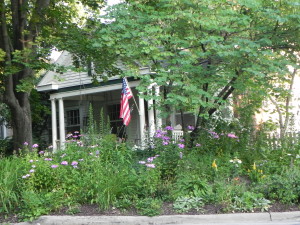
This lovely landscape adds beauty to the neighborhood and welcomes pollinators.
Worldwide concern over dramatic declines in honeybee populations the past few years have hit the news. These intriguing and highly beneficial insects pollinate thousands of species of flowers, but media reports lead us to believe that they are the only pollinator and the disappearance of honeybees will leave plants unable to pollinate. The result will decimate human food supplies.
That’s only true in context. Honeybees are Old World natives introduced to North America in early settlement days. Before Columbus there were no honeybees on the continent, but obviously plants pollinated, thanks to dozens of other insect species as well as a few mammals.
Honeybee loss is of huge concern to anyone who likes to eat because of the way our society farms. Immense monoculture orchards and fields lack habitat for native pollinators. Farmland is often doused with insecticides. Farmers place honeybee colonies in the midst of vast almond and fruit orchards as well as other crops to pollinate these giant biological deserts that can’t support other pollinator species.
Fortunately, there are ways homeowners can welcome pollinators to their yards.
Become a beekeeper. It’s a fascinating hobby that yields satisfaction, pollination and delicious honey. Learning beekeeping takes effort and may not be legal in some cities. Look for future Winding Pathways blogs on beekeeping or contact your local extension agent or nature center to learn about beekeeping classes and locate experienced beekeepers. Beekeepers are usually eager to mentor newcomers.
Create pollinator homes. Mason bees are efficient, fascinating pollinators that are easy to attract to yards. While they do not yield honey they do get the pollination job done. Mason bees lay eggs in cavities in wood and readily use nesting structures placed in a yard. Most garden supply companies sell mason bee “houses” made of many tubes joined together. A mason bee home can be easily made from scrap wood. We made ours from several pieces of scrap 2X6 lumber screwed together to form a thick short piece of artificial tree. We drilled holes in it for the bees to raise their larvae, painted it and hung it from our deck. A few bees used it the first season with more moving in the next year. Google “Mason Bee” and choose from the many plans.
Create a pollination pocket, or PP, in the yard. Many pollinators only need a small patch of tall vegetation to hide in and raise their young. Mowed and sprayed lawns lack pollinator habitat. Often vast subdivisions are so manicured that hardly a beneficial insect can live there. So, to create the simplest PP just stop mowing a strip of lawn and let grasses and weeds grow tall there. The bigger the patch the better but even a 10 or 20 foot long and two foot wide strip will house pollinators.
The downside of letting a patch of lawn grow up is that plant species diversity will be limited and problem weeds may grow. Pollinators love weeds, but neighbors don’t. Be creative. The greater the diversity of flowers the more colorful the PP will be, the more beneficial insects it will attract and the more neighbors will like it. Our PPs include a wide variety of native grasses and wildflowers. Because we live in Iowa many of our plants are native prairie species but we also encourage some ornamental exotic flowers. One of our favorites is the cupplant. It’s tall and gangly but dozens of insect species love it. So do goldfinches and hummingbirds! On most sunny summer days tiger swallowtail butterflies and bumblebees visit it. Goldenrods and milkweeds are also outstanding pollinator plants.
A PP can serve many purposes. Tall, colorful patches of flowers and grasses can form walkway boundaries – winding pathways – in the yard and also can put steep or rough hard to mow areas to good use. A PP does more. The plants sink roots deep into the earth holding soil and creating space for rainwater thus reducing runoff. For a tranquil evening activity, sit quietly near a pollination pocket with a pair of binoculars that will focus closely and enjoy the constant coming sand goings of dozens of species of intriguing insects.
Take a step in creating a wondrous yard by creating a pollinator pocket. It will add summer color to the yard and invite all sorts of delightful and helpful insects to cohabit your space.
by Winding Pathways | Jul 14, 2014 | Flowers/Grasses, Nature, Weeds
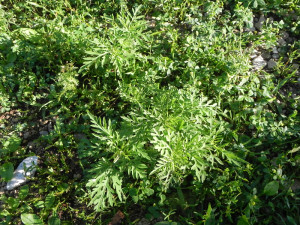
Common Ragweed
Late summer is the dreaded hay fever season! Ragweed is the prime culprit.
Two species of ragweed account for most of the misery. Both are annuals that reseed each year. The seeds only need a bit of bare ground to sprout. They are not fussy, thriving in nearly any type of soil.
True to its name, Common (sometimes called Eastern) Ragweed can be found nearly anywhere people live, especially cities. It can be a prostate plant hugging the ground or sidewalk edge or grow to two or three feet tall on the edge of a yard. Giant (sometimes called Western) Ragweed is less common in suburban and urban areas and can grow to upwards of eight feet tall. It’s abundant on the edge of farm fields where it often forms large thickets. In urban areas Giant Ragweed is most likely found in industrial areas and along railroad tracks. Despite their names either species can be found nearly anywhere in North America, where they are a native plant. Unfortunately ragweed has been introduced to Japan.
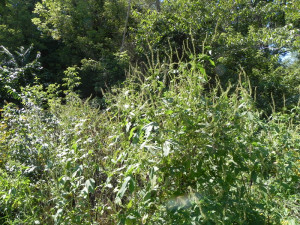
Giant Ragweed
Ragweed causes human suffering because in late summer plants produce green flowers that release millions of pollen grains to the wind. Allergic people react after breathing in the tiny grains, which can blow for miles from the parent plant.
Goldenrods are frequently blamed for causing hay fever because of an unfortunate coincidence. They bloom during hay fever season. Goldenrod flowers are a bright yellow, designed to attract pollinating insects. They do not release pollen into the air and are unjustly blamed for causing human misery.
Despite causing hay fever, ragweeds have ecological value. They are a pioneer weed that quickly becomes established on bare soil. Roots hold the soil, preventing erosion. Within a few years ragweeds usually vacate the spot as more stable perennials move it. Ragweed seeds are devoured by many bird species such as quail.
As a general rule any plant that produces unshowey flowers is a wind pollinator that could cause human allergies. This includes many grass and tree species as well as ragweed. In contrast plants that produce colorful showy flowers are normally insect pollinated and don’t cause sneezing.










